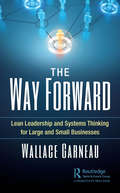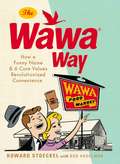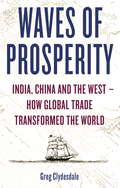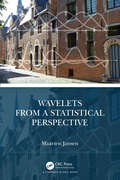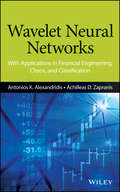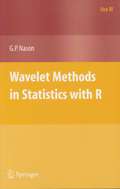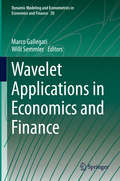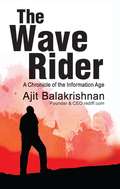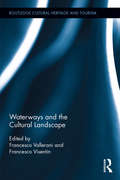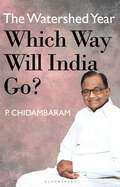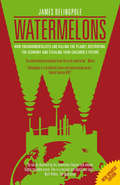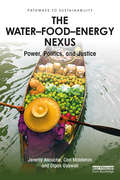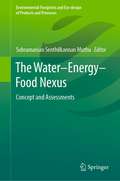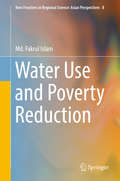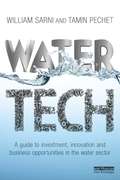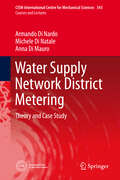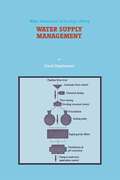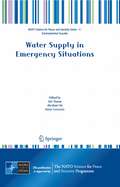- Table View
- List View
The Way Forward: Lean Leadership and Systems Thinking for Large and Small Businesses
by Wallace GarneauThis book helps business leaders see how employees, companies, and missions all interact with each other, as well as with society at large, in systems and subsystems at various levels. It helps leaders learn how to connect the dots, becoming customer-centric in everything they do and then spreading the same goals down to their supply chains. The book discusses what is, and what is not, leadership, covering such topics as statistics-based management, process-improvement, and human resources. The author accomplishes this through a blend of Lean culture and managerial theory, as well as his military experience. In addition, the author contrasts many opposing subjects, such as efficiencies of scale versus efficiencies of build, automation versus process improvement, process innovation versus product innovation, technical versus tactical proficiency, and pull versus push production. With most books focused on Lean initiatives, there is a tremendous amount of benefit involved in creating customer value while reducing waste, but this book takes a holistic approach, blending in modern managerial theory, team leadership skills, and economics. The result is a book that changes how the reader approaches business. Essentially, the purpose of this book is to blend modern management theories with the culture of Lean (and perhaps a sprinkling of economics) to show current business leaders how to create organizations that are as customer-oriented and highly efficient in delivering value as possible. If one thinks of each role in an organization as a spot on an assembly line, where everything each person does creates output someone else uses, the question becomes whether or not each person’s activities maximize the effectiveness of others. Do we, as organizations, set ourselves up for success or for failure? Most companies, if they answer honestly, would say, "A little bit of both." This book is about helping those companies improve.
The Wawa Way: How a Funny Name and Six Core Values Revolutionized Convenience
by Howard StoeckelGrahame Wood opened the first Wawa Food Market in 1964 as an outlet for Wawa dairy products. Since then, the convenience store has grown into a well-known company that competes against the biggest industry players in the world in three areas: fuel, convenience, and food, all while maintaining their personal approach and small business mentality. Now, almost 50 years later, Wawa has opened its first store in Florida and begun to play on the national field. How did it happen? What are the reasons for their success? Why have they been able to go up against the big guys with nothing more than homegrown talent?With a mixture of personal history and business advice, Howard Stoeckel shares the last 50 years of Wawa's growth, development, and expansion. It's the story of how a small company with a funny name made a big difference and all it took was a little goose sense.
The Wawa Way: How a Funny Name and Six Core Values Revolutionized Convenience
by Howard StoeckelWawa, a family business with a history in dairy and manufacturing, expanded into retail in 1964, offering a friendly, personal alternative to supermarkets. Since then, the convenience store grew into a well-known company that competes against the biggest industry players in the world in three areas -- fuel, convenience, and food -- all while maintaining their personal approach and small business mentality. Now, almost 50 years later, Wawa has opened its first store in Florida and has begun to play on the national field. How did it happen? What are the reasons for their success? Why have they been able to go up against the big guys with nothing more than homegrown talent? With a mixture of personal history and business advice, Howard Stoeckel discusses the last 50 years of Wawa's growth, development, and expansion. It's the story of how a small company with a funny name made a big difference, and all it took was a little goose sense.
Waves of Prosperity: India, China and the West – How Global Trade Transformed The World
by Greg ClydesdaleWhen the Venetian merchant, Marco Polo, first arrived in Dynastic China he was faced with a society far advanced of anything he had encountered in Europe. The ports were filled with commodities from all over the eastern world, while new technology was driving the economy forward. It would take another 400 years before European trade in the Atlantic eclipsed the Pacific markets.From China's phenomenally successful Sung dynasty (c. AD 960-1279), Cargoes reveals the power of the Mughals merchants of Gujarat, who built an empire so powerful that, even in the 17th century, the richest man in the world was a Gujarat trader. It was not until the opening up of the spice routes and the discovery of South American gold that medieval Iberia came to the fore. It was only then that the Atlantic Empire of the west came to dominate world trade, first the Dutch Republic in the seventeenth century, then the British Empire in the age of the Industrial Revolution, American supremacy in the twentieth century, and the development of post-war Japan. Along the way Greg Clydesdale looks at the parallel lives and ideas of merchants and explorers, missionaries, kings, bankers and emperors. He shows how great trading nations rise on a wave of technological and financial innovation and how in that success lies the cause of their inevitable decline.
Wavelets from a Statistical Perspective
by Maarten JansenWavelets from a Statistical Perspective offers a modern, 2nd generation look on wavelets, far beyond the rigid setting of the equispaced, dyadic wavelets in the early days. With the methods of this book, based on the lifting scheme, researchers can set up a wavelet or another multiresolution analysis adapted to their data, ranging from images to scattered data or other irregularly spaced observations. Whereas classical wavelets stand a bit apart from other nonparametric methods, this book adds a multiscale touch to your spline, kernel or local polynomial smoothing procedure, thereby extending its applicability to nonlinear, nonparametric processing for piecewise smooth data. One of the chapters of the book constructs B-spline wavelets on nonequispaced knots and multiscale local polynomial transforms. In another chapter, the link between wavelets and Fourier analysis, ubiquitous in the classical approach, is explained, but without being inevitable. In further chapters the discrete wavelet transform is contrasted with the continuous version, the nondecimated (or maximal overlap) transform taking an intermediate position. An important principle in designing a wavelet analysis through the lifting scheme is finding the right balance between bias and variance. Bias and variance also play a crucial role in the nonparametric smoothing in a wavelet framework, in finding well working thresholds or other smoothing parameters. The numerous illustrations can be reproduced with the online available, accompanying software. The software and the exercises can also be used as a starting point in the further exploration of the material.
Wavelets from a Statistical Perspective
by Maarten JansenWavelets from a Statistical Perspective offers a modern, 2nd generation look on wavelets, far beyond the rigid setting of the equispaced, dyadic wavelets in the early days. With the methods of this book, based on the lifting scheme, researchers can set up a wavelet or another multiresolution analysis adapted to their data, ranging from images to scattered data or other irregularly spaced observations. Whereas classical wavelets stand a bit apart from other nonparametric methods, this book adds a multiscale touch to your spline, kernel or local polynomial smoothing procedure, thereby extending its applicability to nonlinear, nonparametric processing for piecewise smooth data. One of the chapters of the book constructs B-spline wavelets on nonequispaced knots and multiscale local polynomial transforms. In another chapter, the link between wavelets and Fourier analysis, ubiquitous in the classical approach, is explained, but without being inevitable. In further chapters the discrete wavelet transform is contrasted with the continuous version, the nondecimated (or maximal overlap) transform taking an intermediate position. An important principle in designing a wavelet analysis through the lifting scheme is finding the right balance between bias and variance. Bias and variance also play a crucial role in the nonparametric smoothing in a wavelet framework, in finding well working thresholds or other smoothing parameters. The numerous illustrations can be reproduced with the online available, accompanying software. The software and the exercises can also be used as a starting point in the further exploration of the material.
Wavelet Neural Networks: With Applications in Financial Engineering, Chaos, and Classification
by Antonios K. Alexandridis Achilleas D. ZapranisA step-by-step introduction to modeling, training, and forecasting using wavelet networks Wavelet Neural Networks: With Applications in Financial Engineering, Chaos, and Classification presents the statistical model identification framework that is needed to successfully apply wavelet networks as well as extensive comparisons of alternate methods. Providing a concise and rigorous treatment for constructing optimal wavelet networks, the book links mathematical aspects of wavelet network construction to statistical modeling and forecasting applications in areas such as finance, chaos, and classification. The authors ensure that readers obtain a complete understanding of model identification by providing in-depth coverage of both model selection and variable significance testing. Featuring an accessible approach with introductory coverage of the basic principles of wavelet analysis, Wavelet Neural Networks: With Applications in Financial Engineering, Chaos, and Classification also includes: • Methods that can be easily implemented or adapted by researchers, academics, and professionals in identification and modeling for complex nonlinear systems and artificial intelligence • Multiple examples and thoroughly explained procedures with numerous applications ranging from financial modeling and financial engineering, time series prediction and construction of confidence and prediction intervals, and classification and chaotic time series prediction • An extensive introduction to neural networks that begins with regression models and builds to more complex frameworks • Coverage of both the variable selection algorithm and the model selection algorithm for wavelet networks in addition to methods for constructing confidence and prediction intervals Ideal as a textbook for MBA and graduate-level courses in applied neural network modeling, artificial intelligence, advanced data analysis, time series, and forecasting in financial engineering, the book is also useful as a supplement for courses in informatics, identification and modeling for complex nonlinear systems, and computational finance. In addition, the book serves as a valuable reference for researchers and practitioners in the fields of mathematical modeling, engineering, artificial intelligence, decision science, neural networks, and finance and economics.
Wavelet Neural Networks: With Applications in Financial Engineering, Chaos, and Classification
by Antonios K. Alexandridis Achilleas D. ZapranisA step-by-step introduction to modeling, training, and forecasting using wavelet networks Wavelet Neural Networks: With Applications in Financial Engineering, Chaos, and Classification presents the statistical model identification framework that is needed to successfully apply wavelet networks as well as extensive comparisons of alternate methods. Providing a concise and rigorous treatment for constructing optimal wavelet networks, the book links mathematical aspects of wavelet network construction to statistical modeling and forecasting applications in areas such as finance, chaos, and classification. The authors ensure that readers obtain a complete understanding of model identification by providing in-depth coverage of both model selection and variable significance testing. Featuring an accessible approach with introductory coverage of the basic principles of wavelet analysis, Wavelet Neural Networks: With Applications in Financial Engineering, Chaos, and Classification also includes: • Methods that can be easily implemented or adapted by researchers, academics, and professionals in identification and modeling for complex nonlinear systems and artificial intelligence • Multiple examples and thoroughly explained procedures with numerous applications ranging from financial modeling and financial engineering, time series prediction and construction of confidence and prediction intervals, and classification and chaotic time series prediction • An extensive introduction to neural networks that begins with regression models and builds to more complex frameworks • Coverage of both the variable selection algorithm and the model selection algorithm for wavelet networks in addition to methods for constructing confidence and prediction intervals Ideal as a textbook for MBA and graduate-level courses in applied neural network modeling, artificial intelligence, advanced data analysis, time series, and forecasting in financial engineering, the book is also useful as a supplement for courses in informatics, identification and modeling for complex nonlinear systems, and computational finance. In addition, the book serves as a valuable reference for researchers and practitioners in the fields of mathematical modeling, engineering, artificial intelligence, decision science, neural networks, and finance and economics.
Wavelet Applications in Economics and Finance (Dynamic Modeling and Econometrics in Economics and Finance #20)
by Marco Gallegati Willi SemmlerThis book deals with the application of wavelet and spectral methods for the analysis of nonlinear and dynamic processes in economics and finance. It reflects some of the latest developments in the area of wavelet methods applied to economics and finance. The topics include business cycle analysis, asset prices, financial econometrics, and forecasting. An introductory paper by James Ramsey, providing a personal retrospective of a decade's research on wavelet analysis, offers an excellent overview over the field.
The Wave Rider: A Chronicle of the Information Age
by Ajit BalakrishnanAjit Balakrishnan is quietly experimenting with the new and fascinating technologies of the Internet in 1995 when the dot-com fever grips the world. Venture capitalists, investment bankers and lawyers pound at the doors of his tiny office in a low-rent area of Mumbai, urging him to take his company public on New York's NASDAQ stock market. Balakrishnan sets out on this enterprise, a path that takes him through the world's financial centres of London, Hamburg, New York, Boston and San Francisco. This story recounts how he battles adversaries many times his size; fends off avaricious lawyers who try to extort money through class action suits in the tough courts of lower Manhattan; rebuffs investment bankers who try to engineer the sale of his company; and tries to make sense of a world where technology and business models change every few months. He steers his company through the financial crashes of 2000 and 2008; watches in awe as terrorists bring down New York's World Trade Centre towers; puzzles over the decline of once famous names such as AOL and Netscape and the rise of new behemoths like Facebook and Google; wrestles with India's legal system; and pushes to bring Rediff into the new world of the Internet. Gradually, he realizes that the battles he is part of are not just business battles - they signal the dawn of the Information Age.
Watford Forever: How Graham Taylor and Elton John Saved a Football Club, a Town and Each Other
by John Preston Elton JohnThe Sunday Times Sports Book of the Year A Times Book of the Year A Financial Times Book of the YearA Guardian Book of the YearA New Statesman Book of the Year'The heartwarming story of the collaboration and friendship between English football’s oddest couple, Elton John and Graham Taylor' The Times ' A wonderful, feel-good account of an ultimately English provincial story' Simon Kuper_____________________ An unforgettable British underdog story from one of our greatest narrative nonfiction writers, John Preston, and the international musical icon and bestselling author, Sir Elton John.Britain in the 1970s was beset by unrest and unemployment, as inflation soared, fuel was scarce, and hooliganism was on the rise. And for Watford FC, the outlook was even gloomier. Rundown and rat-infested, Watford were an ailing side with holes in their kit and barely enough fans to fill a stand. Of the 92 clubs in the Football League, spread across four divisions, Watford were in 92nd place.Meanwhile, Elton John was the most successful rockstar in the world. With six-inch platforms, spangled jumpsuits, and peroxide hair, he was glamorous, gay, and seemingly a world away from the semi-detached house in Pinner where he had supported Watford FC as a child. Many assumed he would move to America. Instead, he bought the football club.Watford Forever is the remarkable story of Elton John's ownership of Watford FC and its transformational journey to the top of the First Division under iconic manager Graham Taylor. Perhaps most remarkably, four of the same players who had been written off as has-beens went with them all the way from the bottom to the top. Inspiring and infectiously funny, this is a tribute to football's unlikeliest friendship as Elton John and Taylor, a straight-talking former fullback with a love of Vera Lynn, beat the odds and their personal demons to save a club and a community.Immersed in the grime and glamour of '70s Britain, Watford Forever is one of sport's great underdog stories and a love letter to the beautiful game.
Waterways and the Cultural Landscape (Routledge Cultural Heritage and Tourism Series)
by Francesco Vallerani Francesco VisentinWater control and management have been fundamental to the building of human civilisation. In Europe, the regulation of major rivers, the digging of canals and the wetland reclamation schemes from the sixteenth to nineteenth centuries, generated new typologies of waterscapes with significant implications for the people who resided within them. This book explores the role of waterways as a form of heritage, culture and sense of place and the potential of this to underpin the development of cultural tourism. With a multidisciplinary approach across the social sciences and humanities, chapters explore how the control and management of water flows are among some of the most significant human activities to transform the natural environment. Based upon a wealth and breadth of European case studies, the book uncovers the complex relationships we have with waterways, the ways that they have been represented over recent centuries and the ways in which they continue to be redefined in different cultural contexts. Contributions recognise not only valuable assets of hydrology that are at the core of landscape management, but also more intangible aspects that matter to people, such as their familiarity, affecting what is understood as the fluvial sense of place. This highly original collection will be of interest to those working in cultural tourism, cultural geography, heritage studies, cultural history, landscape studies and leisure studies.
Waterways and the Cultural Landscape (Routledge Cultural Heritage and Tourism Series)
by Francesco Vallerani Francesco VisentinWater control and management have been fundamental to the building of human civilisation. In Europe, the regulation of major rivers, the digging of canals and the wetland reclamation schemes from the sixteenth to nineteenth centuries, generated new typologies of waterscapes with significant implications for the people who resided within them. This book explores the role of waterways as a form of heritage, culture and sense of place and the potential of this to underpin the development of cultural tourism. With a multidisciplinary approach across the social sciences and humanities, chapters explore how the control and management of water flows are among some of the most significant human activities to transform the natural environment. Based upon a wealth and breadth of European case studies, the book uncovers the complex relationships we have with waterways, the ways that they have been represented over recent centuries and the ways in which they continue to be redefined in different cultural contexts. Contributions recognise not only valuable assets of hydrology that are at the core of landscape management, but also more intangible aspects that matter to people, such as their familiarity, affecting what is understood as the fluvial sense of place. This highly original collection will be of interest to those working in cultural tourism, cultural geography, heritage studies, cultural history, landscape studies and leisure studies.
The Watershed Year: Which Way Will India Go
by P ChidambaramAugust 15, 2022 marked the beginning of India's 75th year of independence. The year was significant in another way too-as the precursor to elections in 2024. With an incumbent government that in the last ten years has undertaken widespread changes, some controversial, how the people will vote in this election points to more than the usual selection of representatives to the Parliament: they would also be showing their approval for the direction some would like the country to take.Is India still a secular, sovereign, democratic country in the same sense as the founding fathers of the republic envisaged? How has the country fared on matters of governance? Do the economic policies assure a secure future for the people?As P. Chidambaram reminds us, democracy is not just voting once every five years. Democracy has to be practised every day, through dialogue, discussion, debate and dissent. His column takes on the issues without flinching or ambiguity. It is an Opposition view, but even discounting party politics, one that provides a valuable perspective.As India prepares for elections, the arguments in The Watershed Year will help clarify the basis for judging which way we want to go.
Watermelons: How Environmentalists are Killing the Planet, Destroying the Economy and Stealing Your Children's Future
by James DelingpoleIf global warming isn't real then how come the ice caps are melting? Why would all the world's top scientists lie to us? What exactly is so wrong with biofuels, wind farms, carbon taxes, sustainability and preserving scarce resources for future generations? And what about Bangladesh, the drowning Maldives and all those endangered polar bears? James Delingpole has all the answers - and they're not the ones Al Gore would like you to hear. In Watermelons, Delingpole tells the shocking true story of how a handful of political activists, green campaigners and voodoo scientists engineered the world's biggest, most expensive and destructive outbreak of mass hysteria - one that threatens the very fabric of Western Civilisation.
The Water–Food–Energy Nexus: Power, Politics, and Justice (Pathways to Sustainability)
by Jeremy Allouche Carl Middleton Dipak GyawaliThe world of development thinkers and practitioners is abuzz with a new lexicon: the idea of "the nexus" between water, food, and energy which is intuitively compelling. It promises better integration of multiple sectoral elements, a better transition to greener economies, and sustainable development. However, there appears to be little agreement on its precise meaning, whether it only complements existing environmental governance approaches or how it can be enhanced in national contexts. One current approach to the nexus treats it as a risk and security matter while another treats it within economic rationality addressing externalities across sector. A third perspective acknowledges it as a fundamentally political process requiring negotiation amongst different actors with distinct perceptions, interests, and practices. This perspective highlights the fact that technical solutions for improving coherence within the nexus may have unintended and negative impacts in other policy areas, such as poverty alleviation and education. The Water–Food–Energy Nexus: Power, Politics and Justice lays out the managerial-technical definitions of the nexus and challenges these conceptions by bringing to the forefront the politics of the nexus, around two key dimensions – a dynamic understanding of water–food–energy systems, and a normative positioning around nexus debates, in particular around social justice. The authors argue that a shift in nexus governance is required towards approaches where limits to control are acknowledged, and more reflexive/plural strategies adopted. This book will be of interest to academic researchers, policy makers, and practitioners in the fields of international development studies, environmental politics, and science and technology studies, as well as international relations.
The Water–Food–Energy Nexus: Power, Politics, and Justice (Pathways to Sustainability)
by Jeremy Allouche Carl Middleton Dipak GyawaliThe world of development thinkers and practitioners is abuzz with a new lexicon: the idea of "the nexus" between water, food, and energy which is intuitively compelling. It promises better integration of multiple sectoral elements, a better transition to greener economies, and sustainable development. However, there appears to be little agreement on its precise meaning, whether it only complements existing environmental governance approaches or how it can be enhanced in national contexts. One current approach to the nexus treats it as a risk and security matter while another treats it within economic rationality addressing externalities across sector. A third perspective acknowledges it as a fundamentally political process requiring negotiation amongst different actors with distinct perceptions, interests, and practices. This perspective highlights the fact that technical solutions for improving coherence within the nexus may have unintended and negative impacts in other policy areas, such as poverty alleviation and education. The Water–Food–Energy Nexus: Power, Politics and Justice lays out the managerial-technical definitions of the nexus and challenges these conceptions by bringing to the forefront the politics of the nexus, around two key dimensions – a dynamic understanding of water–food–energy systems, and a normative positioning around nexus debates, in particular around social justice. The authors argue that a shift in nexus governance is required towards approaches where limits to control are acknowledged, and more reflexive/plural strategies adopted. This book will be of interest to academic researchers, policy makers, and practitioners in the fields of international development studies, environmental politics, and science and technology studies, as well as international relations.
The Water–Energy–Food Nexus: Concept and Assessments (Environmental Footprints and Eco-design of Products and Processes)
by Subramanian Senthilkannan MuthuWater, Energy and Food are the very basic necessities of human life and all the three of them are interconnected with each other, this connection being called the Water-Energy-Food nexus. Water is an inevitable element to energy and food systems to work. Water is essential for the growth of crops and produce energy and it consumes a lot of energy to treat and move water. Food and energy are equally dependent upon each other as well. This book highlights with various examples and case studies from around the World, the importance of this concept.
Water Use and Poverty Reduction (New Frontiers in Regional Science: Asian Perspectives #8)
by Md. Fakrul IslamThis book is the outcome of empirical research on the sharing of water of the Teesta River, which flows through India and Bangladesh. The main purpose is to show how regional cooperation between India and Bangladesh regarding sharing of Teesta River water can ensure optimal benefits for people living in the area of the Teesta Basin located in the two countries. The author takes an interdisciplinary approach focusing on the relationship between availability of water and the reduction of poverty in the Teesta Basin as a whole. The book presents findings of a comparative socioeconomic survey on the Dalia and Gazoldoba irrigable areas, with background information on the Teesta River and its origin, spatio-physical nature, geomorphic and hydrological characteristics, irrigation and water delivery system through the Gazoldoba barrage in India and the Dalia barrage in Bangladesh. Citing the principles of transboundary freshwater sharing, this work focuses on different approaches to international water sharing and introduces an optimal approach to dry season water sharing and welfare maximization by developing a bilateral water sharing model. The model is tested through computer simulation, and an alternative water allocation policy is proposed. Water Use and Poverty Reduction is highly recommended to readers who seek an optimum solution to transboundary and bilateral water sharing and poverty reduction issues.
Water Tech: A Guide to Investment, Innovation and Business Opportunities in the Water Sector
by William Sarni Tamin PechetThis book unveils how the world in the twenty-first century will need to manage our most fundamental resource need, water. It outlines how stakeholders can improve water use in their homes, their businesses, and the world. In particular, it focuses on the role of stakeholders in crafting a twenty-first century paradigm for water. Investors not only drive innovation through direct investment in new technologies but also by highlighting risk and driving reporting and disclosure within the business community. Water Tech highlights the business drivers to address water related issues. These include business disruption, regulatory risk and reputational risk along with opportunities in the commercialization of innovative technologies such as desalination and water reuse and treatment. The authors argue that through increased attention on water scarcity through activities such as reporting and disclosure we are now accelerating innovation in the water industry. They show how we are just now capturing the true cost and value of water and this is creating opportunities for investors in the water sector. The text takes the reader through key aspects of emerging innovative technologies along with case studies and key issues on the path to commercialization. A roadmap of the opportunities in the water sector is presented based on interviews with leading authorities in the water field including innovators, investors, legal, regulatory experts and businesses.
Water Tech: A Guide to Investment, Innovation and Business Opportunities in the Water Sector
by William Sarni Tamin PechetThis book unveils how the world in the twenty-first century will need to manage our most fundamental resource need, water. It outlines how stakeholders can improve water use in their homes, their businesses, and the world. In particular, it focuses on the role of stakeholders in crafting a twenty-first century paradigm for water. Investors not only drive innovation through direct investment in new technologies but also by highlighting risk and driving reporting and disclosure within the business community. Water Tech highlights the business drivers to address water related issues. These include business disruption, regulatory risk and reputational risk along with opportunities in the commercialization of innovative technologies such as desalination and water reuse and treatment. The authors argue that through increased attention on water scarcity through activities such as reporting and disclosure we are now accelerating innovation in the water industry. They show how we are just now capturing the true cost and value of water and this is creating opportunities for investors in the water sector. The text takes the reader through key aspects of emerging innovative technologies along with case studies and key issues on the path to commercialization. A roadmap of the opportunities in the water sector is presented based on interviews with leading authorities in the water field including innovators, investors, legal, regulatory experts and businesses.
Water Supply Network District Metering: Theory and Case Study (CISM International Centre for Mechanical Sciences)
by Armando Di Nardo Michele Di Natale Anna Di MauroThe management of a water supply network can be substantially improved defining permanent sectors or districts that enhances simpler water loss detection and pressure management. However, the water network partitioning may compromise water system performance, since some pipes are usually closed to delimit districts in order not to have too many metering stations, to decrease costs and simplify water balance. This may reduce the reliability of the whole system and not guarantee the delivery of water at the different network nodes. In practical applications, the design of districts or sectors is generally based on empirical approaches or on limited field experiences. The book proposes a design support methodology, based on graph theory principles and tested on real case study. The described methodology can help water utilities, professionals and researchers to define the optimal districts or sectors of a water supply network.
Water Supply Management (Water Science and Technology Library #29)
by D. StephensonSupply of sufficient clean drinking water is often taken for granted, but it requires a considerable technical and financial effort to ensure reliable and economic water supply. This volume presents an up-to-date overview of water supply management and aims at efficient management of water supply schemes rather than design of new works. Various chapters of the book are devoted to water demands, management of reservoirs and conjunctive use of alternative sources. Asset management and loss control are also considered. Water quality and provision of water to developing communities are also discussed. Water supply management is of concern to developed urban environments as well as developing communities. The book will be equally valuable to the practising water engineer and the newcomer or graduate student in the subject.
Water Supply in Emergency Situations (NATO Science for Peace and Security Series C: Environmental Security)
by Yair Sharan Abraham Tal Harry CoccossisThis book reflects the outcome of a three day NATO Advanced Workshop entitled "Supply of Water to Cities in Emergency Situations." Some 35 experts from 14 countries from Europe, the Middle East and Asia assembled in Tel-Aviv for this event. It illuminates a broad spectrum of problems and concerns to the orderly water supply ranging from floods to a surprisingly low concern related to intentional terror-related threats.
